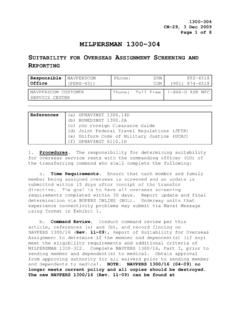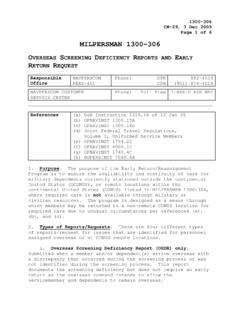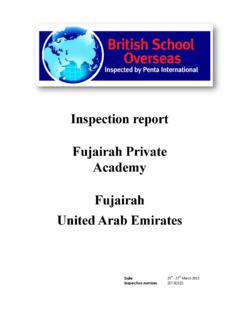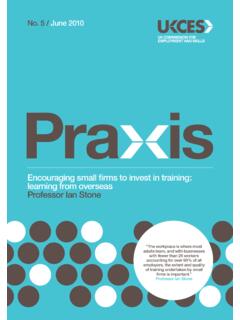Transcription of Health and Safety Executive
1 Health and Safety ExecutiveProtecting migrant workers1 of 5 pagesWho should read this guidance?1 If you employ migrant workers (who have come to work in Great Britain in the last five years and are working legally or otherwise), or other recently arrived workers from overseas, this guidance shows the kind of approach a small business can take. Use it to help you think through some of the problems that can arise, and the steps you need to take to make sure risks are controlled. Risk assessment and control2 Risk assessment is a careful examination of what could cause harm to people in your workplace. It helps you weigh up whether you have taken enough precautions to protect them or need to do more. Risk assessment is a legal requirement under the Management of Health and Safety at Work Regulations 1999. It is also the key to effectively managing Health and Safety , and can reduce the potential for accidents and ill Health that may ruin lives and seriously affect your business if output is lost, or plant, machinery or property is damaged.
2 3 If you have migrant workers in your workplace you will need to consider in particular:language and communication issues; basic competencies, such as literacy, numeracy, physical attributes, general Health , and relevant work experience;whether vocational qualifications are compatible with those in Great Britain, and are genuine; the possible effects of the attitudes and assumptions of workers new to work in Great Britain, or of British workers towards them. 4 This guidance explains how to assess these issues, and what to do about them. How much you need to do to control and monitor those risks will depend on how well you re already meeting legal requirements, and on the particular methods you ve chosen to protect your migrant workers. Remember to consult and involve employees and Trade Union and employee Health and Safety representatives about your risk assessments.
3 Once you ve done an assessment and checked what more you may need to do, you ll need to make sure it is regularly reviewed and kept up to date, including any changes to processes or working Also look at:HSE s web guidance for employers of migrant workers at ; s (or in Scotland) for employers (labour users) and labour providers/employment of 5 pagesHealth and Safety ExecutiveProtecting migrant workers6 Other relevant guidance includes UK Border Agency information on the checks needed before migrant workers can work legally in Great Britain ( ) though Health and Safety law protects all migrant workers, legally employed or not. Employers in agriculture and food processing will also be subject to the Gangmasters Licensing Authority licensing requirements (see ). The Equality and Human Rights Commission provides advice and guidance on discrimination and fair treatment at work ( ).
4 CommunicationsWhat could be a problem?7 Communications could be poor due to lack of spoken or written English, or limited understanding of English, as well as poor comprehension, for example of signs or signals. 8 This means workers:may not understand Health and Safety training/instructions given; may misunderstand Safety critical communications or hand signals from work colleagues, or be unable to use them to warn others in an emergency;may not be able to communicate effectively with supervisors; may not understand each other, even if they come from the same region of the world or are from similar ethnic groups. Examples of what you could do to help meet legal requirements9 You could:use translated materials (for simple, short phrases, try sites like Google language tools or Babel Fish on the internet) or an interpreter; use a buddy system, pairing less experienced workers with experienced co- workers who speak the same language;use DVDs (like the Napo series) or signs instead of written information/ instructions;provide clear explanation of signs (including hand signals) and instructions for emergencies;train supervisors in how to communicate clearly.
5 Supervisors also need to monitor the effectiveness of training for example, by questioning workers about the training or instruction given, or watching how well they follow it in things to consider10 Your particular circumstances may mean you need to:arrange for competent checking of the quality of interpreting or translation if you rely on these methods for putting information across;put flexible arrangements in place to allow attendance at courses in workplace English for speakers of other languages, if available locally. (Train to Gain may be able to help fund these see ) This could help reduce your need for interpreting and translation;do a skills audit to show where other workers are on site who can help if a worker has difficulty communicating. You could turn this into a site map and display for workers to of 5 pagesHealth and Safety ExecutiveProtecting migrant workersConfusionWhat could be a problem?
6 11 Confusion or unfamiliarity, due to lack of experience of the work being done (for example where workers are young) or unfamiliarity with the site, and even with simple This means workers: may not recognise hazards as a potential source of danger; may not understand obvious rules for use of equipment; may be unfamiliar with site layout especially where site hazards may change from day to day, eg in of what you could do to help meet legal requirements13 You could: make sure labour providers/agencies and businesses using temporary workers supplied by them have clear, co-ordinated arrangements for sharing Health and Safety information before temporary/short-term cover workers start;make sure employment agencies supplying temporary workers have carried out suitability checks where relevant, under the Conduct of Employment Agencies and Employment Businesses Regulations 2003 (see );plan induction carefully, including photos of hazards where possible, and provide good-quality information in plain, simple language.
7 Other things to consider14 Your particular circumstances may mean you need to:check your arrangements for supervision are supervisors familiar with the possible problems due to confusion, unfamiliarity and inexperience, their effects and how to manage them?check your arrangements for co-operation and co-ordination with employment agencies or labour providers against the HSE guidance Agency workers Health and Safety on the Businesslink (for England and Wales) or Businessgateway (for Scotland) websites;take time to walk around the workplace or site with workers and show them where the main hazards exist (eg falls, slips and transport), or use a simple colour-coded site hazard map to do could be a problem?15 Competence needed for the work to be done may be inadequate. 16 This means workers:may have qualifications or skills from overseas that are of a lower standard than those required for work in UK;may have forged qualifications or have got them through ID fraud.
8 4 of 5 pagesHealth and Safety ExecutiveProtecting migrant workersExamples of what you could to do to help meet legal requirements17 You could: use the National Recognition Information Centre for the UK (UK NARIC) system ( ) to check whether overseas national-level vocational, academic or professional qualifications are equivalent to GB qualifications, where relevant to the work;translate certificates as a check on their relevance; carry out a practical assessment under supervision to demonstrate competence where there are things to consider 18 Your particular circumstances may mean you need to:develop competencies, for example encouraging migrant workers to become Safety attitudesWhat could be a problem?19 Cultural attitudes and expectations about Health and Safety may undermine good Health and Safety This means workers:may not report accidents because they fear they will be blamed or sacked; may believe accidents are inevitable /just part of life and not play their part in helping to prevent them;may have cultural assumptions about fellow workers which could get in the way of your arrangements for managing Health and Safety for example, older workers may not accept a younger interpreter, or experienced workers may not want to be slowed down by taking responsibility for a new starter;may experience workplace bullying due to cultural differences; may not ask questions to check understanding because of an unquestioning attitude to those in authority;may just want to get on with the job , ignoring the potential for danger.
9 Examples of what you could do to meet legal requirements21 You could:emphasise the importance of reporting accidents and near misses; thoroughly investigate accidents, specifically to ensure underlying causes such as behaviours and attitudes are picked up;explain clearly, during training, your responsibilities for risk assessment and control measures as an employer, and workers responsibilities for their own Health and Safety too;give supervisors guidance on cultural differences that could affect working relationships. For more information on materials available, see the National Centre for Languages Regional Language Networks web pages at 5 of 5 pagesHealth and Safety ExecutivePublished by the Health and Safety Executive Web-only versionOther things to consider22 Your particular circumstances may mean you need to:explain that accidents and near misses are investigated to stop more people being injured and improve conditions for all workers, and aren t used to blame or sack people;encourage workers who are less confident communicating in English to refer concerns to a colleague who can represent informationHSE priced and free publications can be viewed online or ordered from or contact HSE Books, PO Box 1999, Sudbury, Suffolk CO10 2WA Tel: 01787 881165 Fax: 01787 313995.
10 HSE priced publications are also available from information about Health and Safety ring HSE s Infoline Tel: 0845 345 0055 Fax: 0845 408 9566 Textphone: 0845 408 9577 e-mail: or write to HSE Information Services, Caerphilly Business Park, Caerphilly CF83 3GG. This document contains notes on good practice which are not compulsory but which you may find helpful in considering what you need to document is available web-only at: Crown copyright This publication may be freely reproduced, except for advertising, endorsement or commercial purposes. First published 02/10. Please acknowledge the source as HSE.














